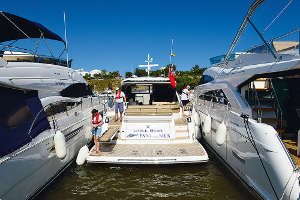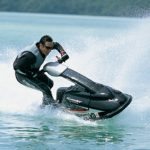Most inexperienced boaters find that many of the skills they’ve learned driving an automobile don’t always apply behind the wheel of their boat. Accustomed to the feel of the rear end of their Chevy following closely in the tracks of the front end when cornering, the boat, they soon learn, pivots from a point about a third of the way back. Pulling away from a pier becomes a frustrating experience when the stern repeatedly bangs into the dock as the captain turns the wheel seaward.
In due time, however, the newer boater gets used to the idea that he or she must allow a wider berth on turns, and the dents and nicks in the rub rail get less numerous. Boat handling skills in general improve with time, as the boater becomes more confident and gathers more experience.
When it comes to maneuvering your boat in reverse, however, more practice and a whole new set of boating skills are required.
Operating astern is commonly referred to by the novice nautician as “backing up.” Personally, I’ve always had trouble with “backing up,” because to me it was always backing “back,” not “up.” So let’s talk about going in reverse as “moving astern.” It’ll make us more popular at the Yacht Club, and it will give people who don’t know you well the impression that you have lived your life on the sea.
If you are operating a boat with an outboard engine, you have the easiest job of all when it comes to backing back. You turn the wheel or push the tiller one way or the other, and the propeller moves from side to side, pulling the stern in the direction you want it to go. You do have to be a little careful about the speed at which you move astern, since you’ll be pushing against the water with the flat surface of your transom. Too fast, and water will come over your transom and swamp your boat. With any vessel, you also must watch the swing of your bow, which can make a rather wide, sweeping movement as you turn in reverse. You don’t want it to hit something or someone.
An inboard/outboard, or I/O, handles in a manner similar to an outboard, but the outdrive unit is not visible to the helmsman, and therefore precise maneuvering is more a factor of observing boat reaction than of watching the changing position of the outboard. The transom usually is higher on an I/O powered vessel, and therefore there is less risk of swamping with the boat moving astern.
Skillful backing of a twin-engine inboard vessel is remarkably easy, once you have become accustomed to the tightness and feel of the controls. Put both rudders in a straight-ahead position, and leave them there. To back back in a straight line, put both engines in reverse, with the same amount of throttle on each engine. To back slowly to port, increase the throttle on the starboard engine and decrease throttle on the port side, or to turn even more quickly, put the port side engine in neutral. With practice, you will be able to pivot the vessel on its stern. Just give yourself plenty of room to practice. If your boat is 30 feet long, you’ll be swinging in a circle with a 30-foot radius.
Backing a single engine inboard vessel is a bit more challenging, and probably will require considerable practice to be good at it. The reason that a single engine inboard is more difficult to maneuver in reverse is because the single propeller is creating a paddle-wheel effect. Each time one of the propeller blades slaps the water, it tries to pull the stern of the boat in the direction the prop is turning. You can’t “aim” the propeller in any direction you wish, like you can with an outboard or I/O because the prop on an inboard is fixed on a shaft, and steerage is accomplished by moving a rudder back and forth in the propeller’s wash. Since the rudder is aft of the propeller, the water being moved by the prop in reverse passes across the rudder before being drawn into the prop, lessening the efficiency of the rudder.
So if you have a single-engine outboard, you’re going to have to spend some time studying and practicing in order to become proficient at backing into tight spots, and may find that you’ll be altering your plans at times to conduct your maneuvers with the gearshift in forward.
If you want to practice sternward maneuvers, pick a calm day and a spot with little boat traffic, stop your boat, and toss something overboard that floats high in the water. Then practice backing back on the float. Soon, you’ll have the feel of your controls and know how your boat reacts at various speeds, and wind and wave conditions in reverse.
A final point. Never back back in shallow water where your prop could strike bottom or rocks, or when there may be someone in the water behind your boat. If in doubt, don’t even bother to take the time and movement to shift to neutral if you think someone may be in the water near your stern. Shut the engine OFF!
Brushing up on your boat handling skills is important, and knowing how to maneuver in reverse is essential to those skills. Have fun and good luck!
If you’re like me, I enjoy playing card games, especially poker with my friends when on my boat!
Here’s a page of fun boating game ideas – http://betterboat.com/pontoon/games-to-play-on-a-pontoon-boat/








